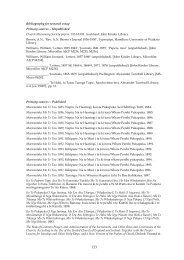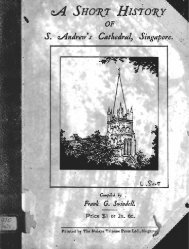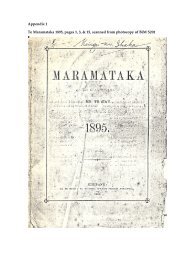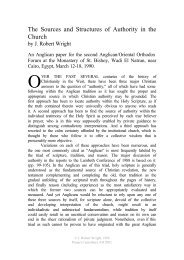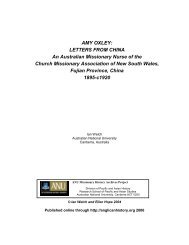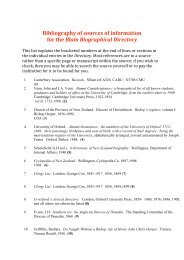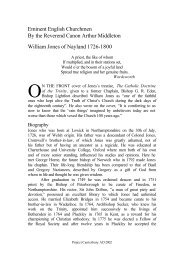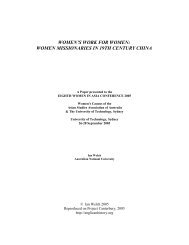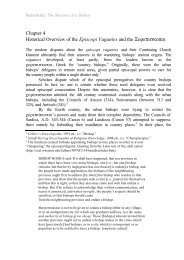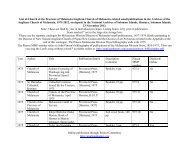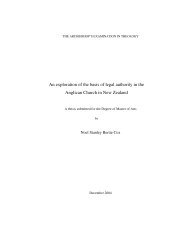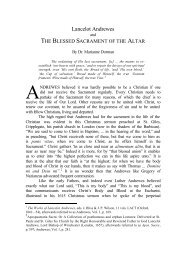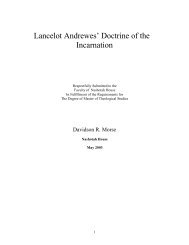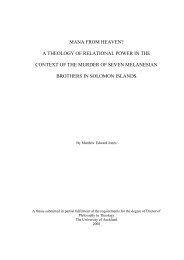The Influence of John Mason Neale and the - Project Canterbury
The Influence of John Mason Neale and the - Project Canterbury
The Influence of John Mason Neale and the - Project Canterbury
Create successful ePaper yourself
Turn your PDF publications into a flip-book with our unique Google optimized e-Paper software.
<strong>The</strong> <strong>Influence</strong> <strong>of</strong> J.M. <strong>Neale</strong> <strong>and</strong> <strong>the</strong> <strong>The</strong>ology <strong>of</strong> Symbolism, by S.D. de Hart<br />
<strong>Neale</strong>’s independence <strong>of</strong> <strong>the</strong> Tractarians was not out <strong>of</strong> disapproval <strong>of</strong> <strong>the</strong> teaching,<br />
though he admittedly was frustrated with <strong>the</strong> doctrines that lacked outward expression. In<br />
writing to Benjamin Webb, 1844, <strong>Neale</strong> remarks:<br />
I hope <strong>and</strong> trust you are not going to Oxonianize. It is clear to me that <strong>the</strong><br />
Tract writers missed one great principle, namely that <strong>of</strong> Aes<strong>the</strong>tics, <strong>and</strong> it is<br />
unworthy <strong>of</strong> <strong>the</strong>m to blind <strong>the</strong>mselves to it. 4<br />
Attempting to go beyond <strong>the</strong> Tractarians did not mean that his thoughts differed<br />
greatly from <strong>the</strong>irs. It is evident that <strong>Neale</strong>’s attempt to relate <strong>the</strong> physical to <strong>the</strong> unseen<br />
world <strong>of</strong> spirit as a means <strong>of</strong> communicating <strong>the</strong> grace <strong>of</strong> God was one <strong>of</strong> <strong>the</strong> foremost<br />
doctrines <strong>of</strong> Pusey <strong>and</strong> <strong>the</strong> Oxford Movement. 5<br />
<strong>The</strong> importantce <strong>and</strong> energy <strong>of</strong> <strong>Neale</strong>’s work became most evident with <strong>the</strong><br />
Cambridge Camden Society, founded in 1839 by <strong>Neale</strong>, E.J. Boyce, <strong>and</strong> Benjamin Webb.<br />
It was named after William Camden, <strong>the</strong> antiquary, who died in 1623. <strong>The</strong> object <strong>of</strong> <strong>the</strong><br />
Society was ‘to perpetuate <strong>and</strong> render accessible whatever is valuable, but at present little<br />
known, amongst <strong>the</strong> materials for <strong>the</strong> civil, ecclesiastical or literary hi <strong>of</strong> <strong>the</strong> United<br />
Kingdom.’ 6 Beginning in 1841, <strong>the</strong> Society published a magazine called <strong>The</strong><br />
Ecclesiologist. In 1846 <strong>the</strong> Cambridge Camden Society changed <strong>the</strong>ir name to <strong>the</strong><br />
Ecclesiological Society, <strong>and</strong> its determined aim was now concerned with ‘<strong>the</strong> science <strong>of</strong><br />
symbolism; <strong>the</strong> principle <strong>of</strong> church arrangements; church music <strong>and</strong> all <strong>the</strong> decorative<br />
arts, which can be m subservient to religion.’ 7<br />
In <strong>the</strong> formative stages <strong>of</strong> <strong>the</strong> Ecclesiological Society, <strong>Neale</strong> had interest in <strong>the</strong><br />
question <strong>of</strong> Eucharistic Vestments <strong>and</strong> purposed that his work would lead to a reintroduction<br />
<strong>of</strong> <strong>the</strong> vestment in Church <strong>of</strong> Engl<strong>and</strong> services. In <strong>the</strong> preface to <strong>the</strong><br />
Hierurgia Anglicana, a product <strong>of</strong> <strong>the</strong> Ecclesiological Society, we get a glimpse <strong>of</strong><br />
<strong>Neale</strong>’s ambitions for <strong>the</strong> Society; “In reference to <strong>the</strong> Eucharistic Vestments in<br />
particular, we are surprised that <strong>the</strong> ecclesiological movement <strong>of</strong> <strong>the</strong> last ten years has<br />
accomplished little or nothing towards <strong>the</strong>ir restoration.” 8 This reference to <strong>the</strong> vestments<br />
<strong>and</strong> <strong>the</strong> desire for <strong>the</strong>ir restoration complements <strong>the</strong> idea running through <strong>Neale</strong>’s o<strong>the</strong>r<br />
early writings. 9<br />
It was during his years as a Cambridge University student that <strong>John</strong> <strong>Mason</strong> <strong>Neale</strong><br />
made an initial study <strong>of</strong> church architecture. <strong>The</strong> result <strong>of</strong> this study led <strong>Neale</strong> to <strong>the</strong><br />
principles that remain <strong>the</strong> most comprehensive analysis <strong>of</strong> what <strong>the</strong> <strong>the</strong>ology <strong>of</strong><br />
symbolism is. In 1843, <strong>John</strong> <strong>Mason</strong> <strong>Neale</strong> <strong>and</strong> Benjamin Webb translated <strong>and</strong> included<br />
4 A.G. Lough, <strong>John</strong> <strong>Mason</strong> <strong>Neale</strong>. Priest Extraordinary, (Devon: A.G. Lough, 1975), p. 55.<br />
5 cf. Ge<strong>of</strong>frey Rowell, <strong>The</strong> Vision Glorious, (Oxford: Oxford University Press, 1983), p. 100.<br />
6 A.G. Lough, <strong>John</strong> <strong>Mason</strong> <strong>Neale</strong>. Priest Extraordinary, p. 16.<br />
7 Kenneth Hylson-Smith, High Churchmanship in <strong>the</strong> Church <strong>of</strong> Engl<strong>and</strong>, (Edinburgh: T & T Clark, 1993), p. 213.<br />
8 Ecclesiological Society, Hierurgia Anglicana, (London: Rivington, 1848), p. ix.<br />
9 As early as 1843, <strong>Neale</strong> remarked ‘I am sure that when once churches are built or restored to be equal to those <strong>of</strong> olden<br />
times,...<strong>the</strong> poverty <strong>of</strong> our present vestments will become intolerable.’ Hierologus, p. 71. He also wrote to Benjamin<br />
Webb in 1846, “<strong>The</strong> great use <strong>of</strong> <strong>the</strong> cope is, it strikes me, to accustom our people to coloured vestments; once do<br />
that <strong>and</strong> do it on such irrefragable Anglican grounds as we have, <strong>and</strong> <strong>the</strong> Chasuble follows without difficulty.”<br />
Letters, p. 94.<br />
[2]



